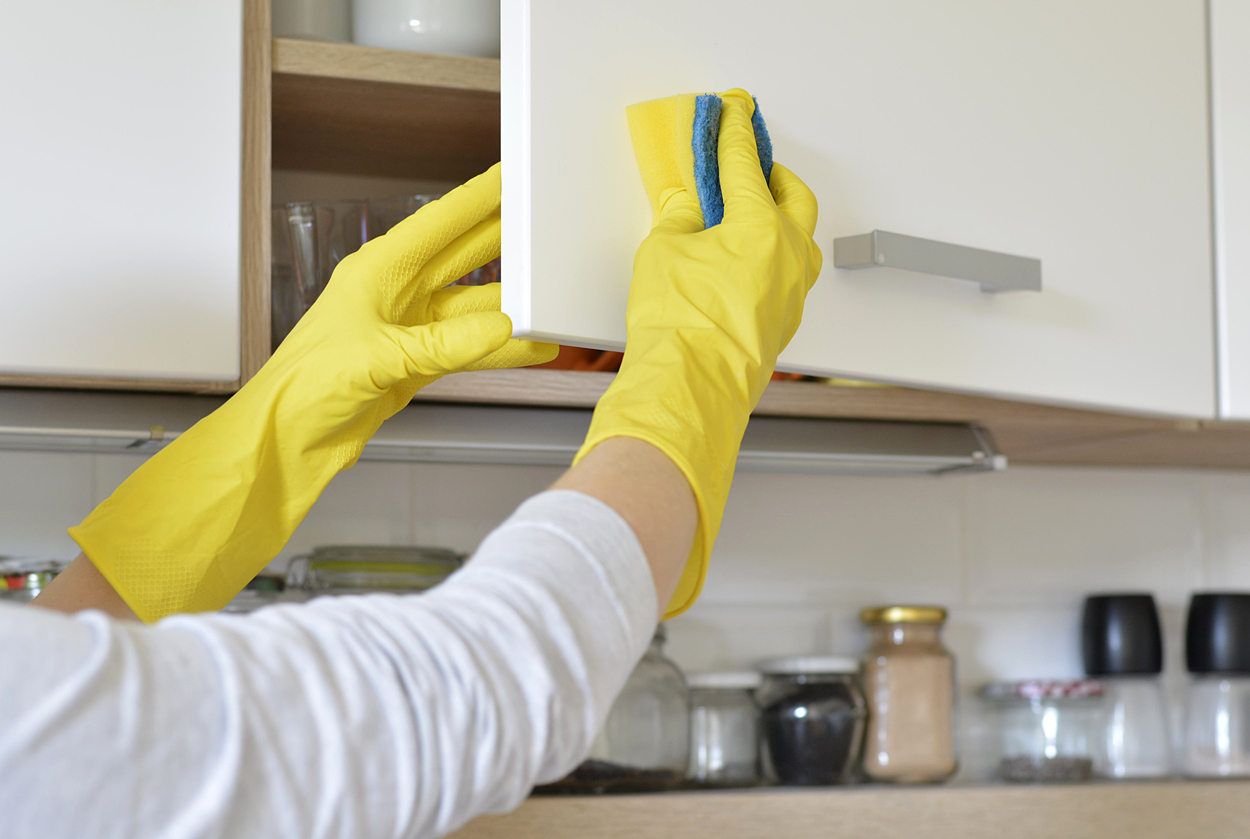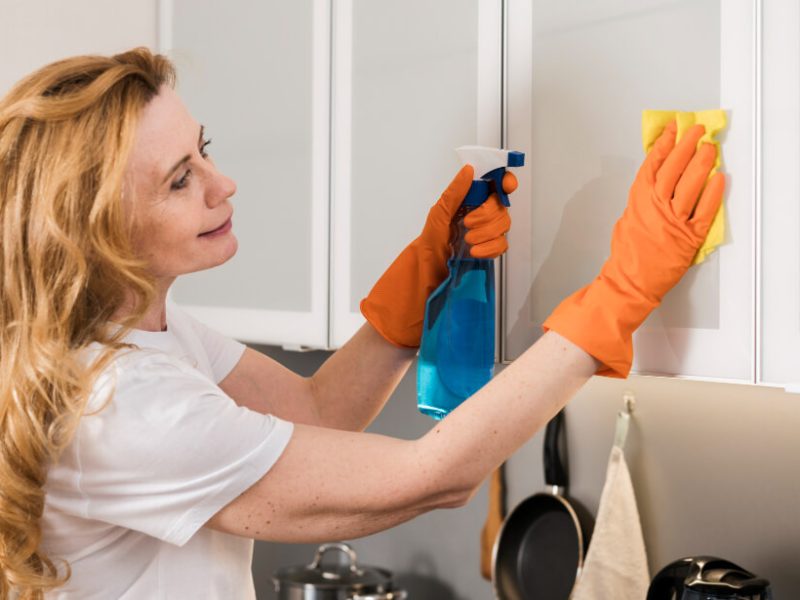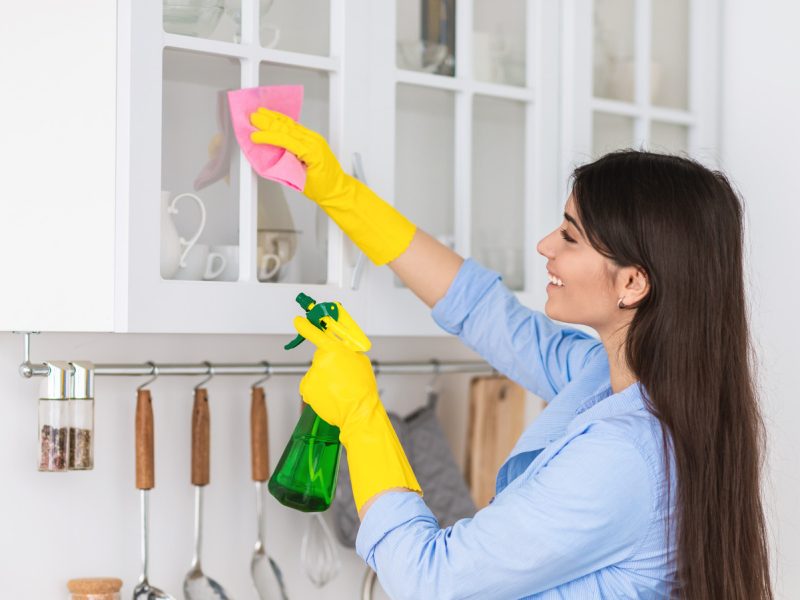If you have been dealing with grease splatters on your kitchen walls, you know how hard it can be to remove them. Grease can be especially stubborn, and it can seem like no matter how hard you scrub, it won’t come off. Don’t worry, several methods can help you remove grease from your kitchen walls. With the right techniques, you can make your kitchen walls look like new again. This guide will provide you with step-by-step instructions on how to remove grease from your kitchen walls.

Why Grease Builds Up on Kitchen Walls
Grease build-up on kitchen walls is an unfortunately common problem in many homes. Grease and cooking oils from everyday cooking activities can accumulate on kitchen walls over time, leading to a greasy and unsightly mess. Grease buildup can happen on any surface in the kitchen, but it is particularly common on walls around stoves, ovens, and other cooking appliances. It can also accumulate on light fixtures and other fixtures near the cooking area.
The primary reason why grease builds up on kitchen walls is the combination of heat and humidity from cooking. The heat and humidity draw the grease and oils out of the food and into the air, where it eventually settle onto kitchen walls and other surfaces. Additionally, grease can also splatter onto walls and other surfaces as food is cooked. Over time, this grease can accumulate and create a greasy mess.
The key to reducing and preventing grease buildup on kitchen walls is to ensure that kitchen areas are properly ventilated. This will help reduce the heat and humidity in the kitchen and will help keep grease and oils from accumulating on walls and other surfaces. Additionally, regularly wiping down kitchen walls and surfaces with a greasy cleaning solution can help reduce the amount of grease build up on kitchen walls over time.
What You’ll Need to Remove Grease
Removing grease from kitchen walls can be a tricky job, but it’s completely possible with the right supplies. To effectively remove grease, you’ll need a few items. First, you’ll need a cleaner specifically designed to tackle grease stains, such as a degreaser or a degreaser-based all-purpose cleaner. Secondly, you’ll need a soft cloth or sponge to apply the cleaner to the wall and a mild abrasive like baking soda or scouring powder to help rub off the grease. Finally, you’ll need gloves and protective eyewear to protect yourself from any splashes or fumes. With the right supplies and a bit of know-how, you can easily and safely remove grease from kitchen walls.
Preparation Before Cleaning
If you have grease stains on your kitchen walls, don’t worry – it’s easy to remove them. Before you start cleaning, however, there are a few preparation steps you should take. First, wear protective gloves and make sure the area is well-ventilated. Grease can be difficult to remove, and it’s important to take the necessary safety precautions. Next, cover any appliances, countertops, and floors that are near the grease stain with plastic sheets or towels to protect them from any cleaning products you may use. Once you’ve taken all the necessary safety measures, you’ll be ready to start cleaning.
Using Baking Soda to Remove Grease
Grease is a stubborn substance that can be difficult to remove from kitchen walls. Fortunately, baking soda is an effective cleaning agent that can easily remove grease from surfaces without damaging the paint. Before attempting to clean with baking soda, it’s important to understand the properties of grease and how to use baking soda to remove it.
Grease is composed of a combination of fats, oils, and proteins. Grease can accumulate on kitchen walls due to cooking, splattering, and other activities. Grease can be difficult to remove with regular cleaning products because it is highly adhesive.
Baking soda is an effective cleaning agent for removing grease because it is a mild abrasive that can loosen and help remove grease without damaging the paint. To use baking soda, make a paste by combining baking soda with a small amount of water. Apply the paste to the affected area and scrub gently with a sponge. Rinse the area with clean water and dry with a soft cloth.
Using White Vinegar to Remove Grease
White vinegar is a natural and powerful degreaser that can help remove grease from kitchen walls. It is a versatile cleaning product that is safe to use, non-toxic, and inexpensive. To use white vinegar to remove grease from kitchen walls, start by filling a spray bottle with a solution of equal parts white vinegar and warm water. Spray the solution onto the kitchen wall and let it sit for a few minutes before wiping it off with a clean cloth. This process may need to be repeated a few times to remove stubborn grease. For even better results, mix some baking soda into the solution. The baking soda will help to break down the grease and make it easier to remove. After the grease has been removed, rinse the wall with warm water and dry it off with a clean towel.
Using white vinegar is an effective and safe way to remove grease from kitchen walls. It is a natural and powerful degreaser that can help to clean away stubborn grease and leave your kitchen walls looking spotless. The added baking soda helps to break down the grease even more, making it easier to remove. By following these simple steps, you can easily remove grease from kitchen walls with white vinegar.
Using Commercial Cleaners to Remove Grease
When it comes to removing grease from kitchen walls, commercial cleaners are one of the most popular solutions. These products are designed to break down grease, dirt, and debris so that it can be wiped away with ease. However, it’s important to take the time to find a cleaner that is both effective and suitable for your walls. Some cleaners can be too harsh and can damage the surface, so be sure to read the label carefully.
Once you’ve selected the right cleaner, apply it to the wall and let it sit for the amount of time specified on the label. After the allotted time has passed, use a sponge or cloth to gently scrub the grease away. For tougher stains, you may need to use a brush or a scouring pad. Keep in mind that while commercial cleaners do a great job at removing grease, they may not be able to completely dissolve the stain. If that’s the case, you may have to use specialized grease-fighting products.
Finally, make sure to rinse the wall with soapy water and a damp cloth. This will help ensure that all the grease and cleaner residue is removed, leaving your kitchen walls looking clean and fresh.
Cleaning the Wall After Removing Grease
Having a grease-free kitchen wall is essential for a clean and hygienic kitchen environment. But, how do you effectively remove grease and dirt from kitchen walls? It may seem daunting, but with the right tools and techniques, you can keep your kitchen wall looking spotless with minimal effort.
First, take the time to identify the source of the grease and tackle it at its source. Grease is commonly found on walls near stoves and ovens or in less-frequented kitchen areas. Once you’ve identified the source, you can plan your cleaning strategy.
Next, gather the necessary cleaning supplies. Dish soap, warm water, and a soft sponge will do the trick. For tougher grease stains, you may need to use a specialized grease-removing solution.
Finally, rinse off the wall with warm water. Dry the wall with a clean cloth or paper towel. Once you’ve finished, take a few moments to admire your work. You’ve now removed grease from your kitchen wall and it looks good as new!
Tips to Prevent Grease Buildup
Preventing grease buildup on your kitchen walls is key to keeping them looking clean. Grease can be a stubborn and unsightly problem, but there are several steps you can take to minimize its occurrence. From creating a grease-resistant barrier to regular cleaning, here are some tips to keep your kitchen walls grease-free.
First, create a grease-resistant barrier on your walls. There are numerous products available on the market, such as grease-resistant paint, that will help keep grease from sticking to your walls. This can be a great way to avoid having to clean your walls often.
Second, use a grease-resistant cleaner to clean your walls. These cleaners are specially formulated to break down grease, making it easier to wipe away. Make sure to follow the instructions on the cleaner’s label for the best results.
Third, use a degreasing agent to remove stubborn grease. These agents are powerful and should be used sparingly, as they can be quite harsh. It’s best to spot-test in an inconspicuous area first to make sure it won’t damage the surface.
By following these tips, you can help keep your kitchen walls grease-free and looking great. With a little bit of preventative maintenance, you can keep your kitchen walls looking like new.
Possible Solutions for Stubborn Grease
Kitchen walls often become stained with grease, making it difficult to keep them clean. Grease can be stubborn and hard to remove, but don’t despair. There are several solutions to tackle this problem. From DIY tricks to commercial products, this article will discuss the various ways to remove grease from kitchen walls.
One of the most popular solutions is to use a mixture of baking soda and vinegar. The baking soda helps to lift the grease while the vinegar helps to dissolve it. For tougher grease stains, you can also use a paste made of baking soda and water. Simply apply the paste to the grease and let it sit for several minutes before wiping it away with a damp cloth.
Another solution for stubborn grease is to use a degreaser. Commercial degreasers are formulated to break down grease and can be found in most hardware stores. Be sure to read the instructions and safety warnings carefully before using a degreaser. You may also want to consider wearing protective gloves while using these products.
Finally, you can also use a natural grease-fighting agent such as lemon juice. Lemon juice is a mild acid that helps to break down grease. Simply mix equal parts lemon juice and water and apply it to the grease with a cloth. Let it sit for several minutes before wiping it away.
Removing Grease from Other Kitchen Surfaces
Everyone knows that grease and grime can build up quickly on kitchen walls, but it can also accumulate on other kitchen surfaces like cabinets, countertops, and even appliances. Grease can be difficult to remove, but it is important to get rid of it to maintain a clean and hygienic kitchen. Luckily, there are a few simple techniques to help you remove grease from kitchen surfaces and keep your kitchen looking sparkling clean.
One of the easiest methods for removing grease from kitchen surfaces is to use a mixture of hot water and dish soap. Simply create a solution of hot water and a few drops of dish soap and use a cloth or sponge to scrub the grease away. For tougher grease stains, you can mix a few tablespoons of baking soda with a few drops of dish soap to create a paste. Apply the paste to the grease-stained area and allow it to sit for a few minutes before scrubbing it away. You can also use a commercial degreaser for tough, caked-on grease stains.
Another option for removing grease from kitchen surfaces is to use white vinegar. Vinegar is a natural cleaner and deodorizer and it’s a great solution for removing grease. Simply mix a cup of white vinegar with a cup of hot water and use a damp cloth or sponge to wipe away the grease. For tougher grease stains, create a paste with equal parts white vinegar and baking soda and apply it to the grease-stained surface. Allow it to sit for a few minutes before scrubbing it away.
FAQs About the How To Remove Grease From Kitchen Walls
1. What types of materials can I use to remove grease from kitchen walls?
Answer: To remove grease from kitchen walls, you can use a degreaser, detergent, or white vinegar and water solution.
2. Is it safe to use harsh chemicals to remove grease?
Answer: It is not recommended to use harsh chemicals, such as bleach, to remove grease from kitchen walls as it can cause damage.
3. Is it necessary to rinse off the degreaser or detergent after use?
Answer: Yes, it is important to rinse off the degreaser or detergent after use to avoid leaving any residue on the walls.
Conclusion
Removing grease from kitchen walls is an easy task that can be achieved with the right products and techniques. You can use a combination of commercial degreasers, white vinegar, and baking soda to effectively remove grease from your walls without damaging them. It is important to be gentle and to avoid using abrasive materials when cleaning the walls. With a bit of effort, you can easily keep your kitchen walls grease-free and looking their best.


